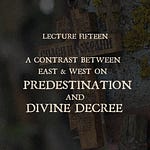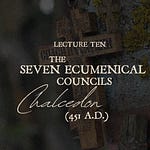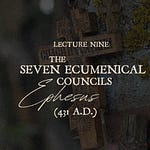These are transcripts from a spoken lecture. The audio is attached to this lesson. If there is any confusion from reading the transcript, please refer to the audio for clarification.
We are on the last of the seven Ecumenical Councils. So we’ve been on this journey through the seven Ecumenical Councils of the early church, and we’ve gone through so far: Nicaea, Constantinople, Ephesus, Chalcedon, Constantinople II, Constantinople III. And now today, we arrive at Nicaea II, the last of our seven Ecumenical Councils.
What we’ve seen to this point is that there has been a consistent commitment to a certain understanding of both the person of Christ and of his work on behalf of humanity in the Christian faith. What we’ve seen is that at Nicaea, there is a commitment to the fact that Christ is fully God. He is homoousios with the Father. He has the same nature as the Father.
At Constantinople, we saw this fleshed out, where the Holy Trinity consists of three hypostases, three individuals or discrete subjects, Father, Son, and Holy Spirit, and that all three, not just the Son, are homoousios. Thus the Holy Spirit too is also divine, as is the Son and the Father, and the Son and Holy Spirit have one common nature, the Son and the Spirit receiving their nature from the Father.
We also saw that at Constantinople, the question of Christ’s humanity began to emerge. As Apollinaris had proposed that perhaps he does not have a human mind. The human mind is replaced by the divine mind. And this, we saw, the council insisted that no, he must have a human mind. He must be homoousios with us, having all that we have, and why? Because he takes on our nature in order to heal that nature, and whatever is not appropriated is not healed. Thus, if he hasn’t taken on the human mind, then that human mind hasn’t been healed.
And thus we saw at Ephesus a new question emerge, though there was agreement that Christ is fully divine and fully human. There was a question of how many persons, and Nestorius had this concern that somehow the two natures being united might be mingled or confused, the ways in which you might put two fluids in a cup and all of a sudden they mingle together and become something new, something that dilutes or distorts what was previously there. And thus Nestorius insisted that, well, each nature must have its own container. It must have its own individual, its own hypostasis, or prosopon, as Nestorius insisted on that term, a face.
And Cyril of Alexandria insisted that no, natures in persons do not necessarily mingle. We have two natures, a spiritual nature, an animal nature. They’re harmoniously held together in our one person, but they don’t mingle. And so it is with Christ. He is only one person having both natures, they are hypostatically united, meaning, the two natures are held together in one person, unconfused and unmingled.
And Cyril insisted that this is the language of Scripture. It is the Word that became flesh and dwelt among us. There is no second person involved. It is the Word who suffers for us. It is the Word who redeems us. And this is why Cyril insisted that we call Mary the Theotokos, the God-birther. Why? Because the person she birthed is the Son of God, the second person of the Trinity.
We saw that there arose a new controversy and worry about Nestorianism and the insulating of the natures. The monophysites and the Eutychians emerged, suggesting that there is, in fact, some sort of mingling of natures.
Now let me give an aside here. Dialog with the monophysites and the miaphysites to this day indicate that perhaps the monophysites do not actually believe that there is a mingling of the natures. It’s tough to say that Eutyches didn’t believe that, but certainly the non-Chalcedonians who held that there is one nature of Christ seemed to be committed to the view of Cyril because Cyril had suggested that them being hypostatically united, those two natures are Christ’s nature. And thus there’s a sense in which we can say these are Christ’s nature. There’s one nature of Christ. And to this day it seems that really, there is a linguistic divide between the non-Chalcedonian miaphysites, or monophysites, and the Orthodox.
But nonetheless, historically, that did create a rift. Returning nonetheless, to the Councils, we saw that over against the miaphysite and the Eutychian controversy, there was an insistence that we reiterate once again that Christ is only one person, having both natures, fully God, fully man, homoousios with the Father, homoousios with us. But these two natures are united in only one person, contrary to the Nestorians. But these two natures do not mingle or get confused, as happens in Eutyches.
Nonetheless, the divine nature energizes the human nature, healing it, not confusing the natures, but rather fulfilling the nature. Why? Because we as humans are icons of God who are made to partake of the divine nature. And thus the energies being communicated from the one nature to another is an actual fulfillment of our nature, not a confusion or mingling of that nature.
And we saw that this is their understanding of the gospel, that the gospel of Christianity, the Christian faith, the Christian religion, what has been handed down to them and handed down to that council, is a faith that insists that we as a dying species who have corrupted ourselves and crippled the ability of us as icons to partake of the divine nature as we are intended to must be healed by our Creator, by the Logos, who takes on our nature, unifies it with divinity, restores it, reorders it, and heals it. And this is the faith that has been handed down at Nicaea.
We now reach a new controversy. Now, again, like with Ephesus, I’d mentioned that every now and then, a certain topic comes up that on first blush, on first appearance, it looks like it’s not about Christ. I’d mentioned this with the Mary controversy. The point of controversy that sparked the Nestorian dispute was the question of, what do we call Mary? And Nestorius had insisted that she’s Christotokos, not Anthropotokos, birther of the man, not Theotokos, birther of the God, but Christotokos, the birther of the two conjoined faces, which is what brought to light Nestorius’ error and what Cyril opposed, insisting on Theotokos. And thus the controversy appeared to center around Mary. But ultimately it was a question about Christ.
And so again, in Nicaea II, we encounter another controversy that has this type of appearance. It’s about iconography, like the icon on the wall back there. This icon controversy, again, to the outsider, might look like, this is just about church practice. This is about artwork, or paintings or something like this. What does this have to do with Christ? And if what I’ve said is true that every council is about “who do you say that I am?” How can we possibly look at a controversy about iconography and suggest that somehow it has something to do with Christ? But as we’ll see, just as in the Mary controversy, so the icon controversy is ultimately a controversy about Christology, and ultimately a controversy about the gospel and the faith that’s been handed down from the apostles to the fathers and ultimately to the council itself.










